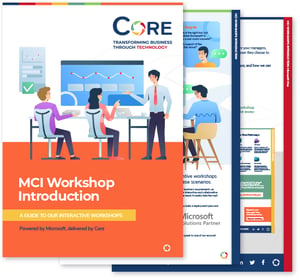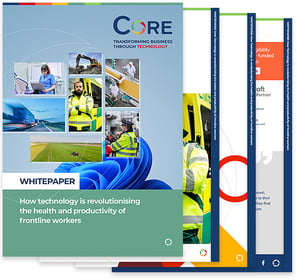Core has configured Microsoft Dynamics CRM specifically for use by membership organisations, to accelerate CRM project delivery based on the best practice we have learned from working with membership organisations for nearly a decade.
In this post, Cheryl Pearce of Core interviews Sue Froggatt, the UK's No.1 Membership Training Provider, to ask her views on membership management, CRM and the future of the sector.
With 30+ years' experience of marketing as well as experience in training, speaking, research and consultancy, predominantly in the membership sector, Sue is uniquely positioned to offer insight on these topics.
Is it fair to say you are an exponent of “experience management”? How would you describe this concept?
SF: Yes – I am definitely an advocate of taking responsibility for managing the customer experience. It has a strategic impact on an organisation, so should not be ignored.
In a nutshell, experience management is about taking an outside-in view. It is about looking at how you make your customers feel when they interact with you. You look at the series of steps and touchpoints involved when they try to get from A to B and intentionally create a consistent experience that your customers value.
Your new book “Managing the Membership Experience” introduces your concept of “Membership Mapping”. How would you describe what this involves and how does it aid today’s membership professionals in reaching their goals?
SF: Membership Mapping TM is a concept and a series of tools that Mark Levin and I have introduced to help membership organisations capture, synthesise and better understand the membership experience. It involves following a step-by-step process. This starts by defining what you want your members to experience. This guides staff, volunteers and interface designers, so that everyone is focused on delivering a consistent experience. You complete this step by adding measures to keep you on track.
The next step is to map out the series of steps the members or prospective members take when they try to get something done. For example, you could map the journey into membership (you would call this the recruitment process) or it could be a simple map of how a member books on an event. After identifying the context or background to the journey, you then describe the key phases involved and for each phase and look in more detail at what is involved. The process identifies where you can improve the experience for the member, particularly areas of high effort for the member, to ensure a smooth, low effort, experience. You can also fine tune your mapping and map journeys for different types or segments of membership. In our book, we give several examples of the key journeys members take.
What is critical here, is that this journey mapping is done, not from your perspective, but from the member’s perspective. Any membership professional interested in improving engagement, increasing retention or improving recruitment, will find the process and tools invaluable.
Do you think the membership sector has changed much in the last five years?
SF: The membership sector is generally slow to change; however, I feel over the past five years, the main area of development has been in their adoption of new technology. They have been catching up, using it to try and create the experiences their members get dealing with other organisations. They have been investing in mobile websites, in new content creation and delivery systems for the growing range of devices now available, and making sure their internal membership systems enable them to deliver what members expect – a faster, more personalised and joined-up service.
In terms of membership development, there has been a shift in focus. There is now more emphasis on member engagement and the membership value proposition, however there is still some way to go, for example we need to move from focus on transactional engagement to emotional engagement and think more about the intangible benefits of membership.
Of course, all membership organisations are different, but membership management includes a number of commonalities most would recognise; in your opinion, what is the biggest challenge membership organisations face right now?
SF: There is not one big challenge but several. The first, is that governance models make association decision making slow and risk averse. These need an overhaul to make them nimble and to make it easier to make decisions. In line with this, the succession planning for volunteer leaders needs to be better resourced so that participation at this level is attractive to all age groups and has members with the right skill sets. Baby Boomers need to make way for Millennials.
The second is the need to focus. Visions and mission statements need to be revisited. They need to be inspiring, short and memorable – so they guide staff every day as to what’s important. They need to reflect a strategic and clear grasp of the emerging trends and what the sector and members will face in the next 25 years. The mission also needs to align with a compelling value proposition for members, generate a sustainable income stream and what makes associations unique.
Related to the above, is that the dues structure of many associations is outdated. They were built to suit the organisation, not the member. They rarely address member motivations and value. This will change, or the association will be left with an increasingly weak and irrelevant value proposition.
Finally, the increasing lack of time and attention is challenging associations. Infoglut, a diet of digital bling, byte sized chunks of information, rapid response expectations and the lack of a formal education process for association professionals, encourages decision making that is devoid of an awareness of the big picture, context and reflection. We also have vast amounts of data we are not analysing for insights. We need more deep thinking, deeper research and better questions. For example, “do we need to measure a sense of belonging? What should we stop doing?
In your experience of working in the membership sector, do you find common issues with member communications? For example, inaccurate data, lack of time to produce content, lack of tailoring of content?
SF: All of your examples crop up as issues. In terms of lack of time to produce content, however, I believe there is a more important role for associations to consider. There is a definite opportunity to add value for members by filtering and analysing the content that has been created by others. Members are looking for help to make sense of all the content out there and highlight what has value, so they can save time and stay on top of what is important. So, the importance of editors and analysts will increase. Members want a trusted source to help them and the good news is research shows members naturally turn to membership bodies for help with this.
I would also add to the list, the existence of silos of information about members across the organisation which weakens an association’s ability to communicate effectively.
Have you witnessed any examples of how increasing engagement with members or prospective members has contributed to retention or recruitment?
SF: SERMO have come from nowhere to become the number one social network for doctors in the US and globally to discuss real world medicine. They started in 2005 and now have over 500,000 members. Engagement has been key to their growth and has worked because doctors feel able to speak their mind and provide honest feedback because comments are anonymous – so no intimidation or recrimination from hospital administrators. Doctors are also encouraged to participate because they can earn an income by providing feedback in focus groups on a broad range of topics.
How do you think CRM technology and processes can help a membership organisation?
SF: Unless a membership organisation is very small, I don’t think that can survive today without an integrated CRM system. A good CRM system will help the members self-serve and customise their membership, to manage what they see and get from membership and how they interact and engage with you and other members. This makes sure membership is relevant to their needs. It can support the delivery of benefits – both the tangible and intangible benefits – and minimise the workload and improve the performance of staff, leaving them free to interact with those members who need and value a more personal approach. It can also monitor what is happening, provide insights for future developments and improve engagement, for example, by making relevant suggestions to members about what else they might value.
What advice would you give to membership organisations considering a new CRM system?
SF: Make sure the users, including both members and staff, are partners in designing and testing the flow, system interfaces and navigation. Don’t just ask for an update of what you currently have in place. See what functionality leading players in the membership and commercial sector are adding. Be prepared for difficult decisions. While it would be great to build something that suits everyone this might limit or complicate development. Focus on what will best support you in the future. What will future members need and expect? When choosing a supplier, be clear about their key points of difference and talk to their current clients. Finally use an agile development process.
Again, objectives will vary from organisation to organisation, but are there any KPIs you regard as essential to measure and report on?
SF: The basic essential measures to report on would be retention rate, number of new members, growth rate and turnover. More insightful measures would include:
- The percentage of bad lapses
- The net promoter score (NPS)
- The member effort scoreA member engagement rating
- A sense of belonging rating
- A membership value rating.
It would also be useful to look at the above for different member segments. I am wary of using the more traditional member satisfaction rating as research has shown that this does not correlate with retention.
How do you think rapidly developing technology such as CRM systems, social media platforms and mobile devices are affecting the sector, in terms of positive and negative impacts?
SF: Social media has been disruptive for associations – you can’t control it and it has taken power away from the organisation to the individual. But social media is really important for associations, because it can add serious value. General networking and facilitating relevant social interactions are key benefits of membership. Social media can facilitate connected conversations ‘on-the-go’ – which has huge value in a knowledge based economy. It can also create a sense of belonging, deliver a sense of self-esteem, provide tools for self-actualisation and provide value for members who don’t show up. However, the downside and problem with social media is that we have the illusion that we are highly connected when we have 500+ contacts, but humans can only genuinely connect with about 150 people. This gives us the impression that things are all joined up, but really, they are more fragmented than we think. We are being trapped by tribalism, silos and tunnel vision – missing the wider context of our actions. But really, the focus should be on human behaviour, not the ‘shiny temptation of new things’. Social media is simply a technology enabled human interaction which is not changing things. It is simply amplifying and enabling more of what drives human beings.
Perhaps a really serious long-term outcome is how the human brain will be changed by the technology of the digital screen age. It will change our relationships, impact on how we think and act, and affect ability to make decisions, concentrate and remember.
Are there any other big changes you foresee in the future for membership organisations?
SF: Technology will certainly continue to bring changes and opportunities for membership organisations. It will be interesting to see what happens in the future with wearable devices recording our behaviours, and introduction of personal robots, or how associations will react when we have machines that are aware of the emotional state of both staff and members.
There will be other external changes to respond to in society (population shifts, social fragmentation, the nature of belonging, time and attention poverty, education, etc.), the economy (how people work, talent shortages, scarcity and abundance of resources, globalisation, etc.) and with political changes (trust, transparency, inclusion, etcetera). It will be increasingly important to get ahead of the curve and predict and track the trends that will impact on your sector, your members and your organisation.
Many membership organisations have been anchoring tenants in their community for a long time, but they will increasingly face competition with the rise in adoption of the membership model by the commercial sector. A different type of leadership will be required to tackle these changes. A recent report on the future of a certain trade association community commented that the quality of leadership will be the single biggest factor in determining organisational success ten years from now.






